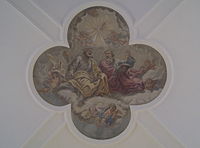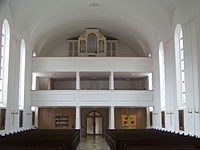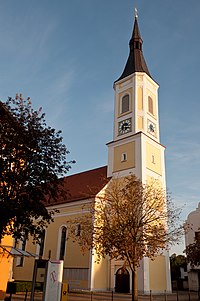St. Peter and Paul (Ergoldsbach)
The Roman Catholic parish church of St. Peter and Paul in Ergoldsbach in the Lower Bavarian district of Landshut is a central building that dates back to 1729. The church is registered as a monument with the number D-2-74-127-7 at the Bavarian State Office for Monument Preservation . Until 1860, the apostle Peter was always named as the patron saint of the church ; in 1916, Peter and Paul were mentioned together for the first time in a diocesan register (feast day: June 29).
history
A church in Ergoldsbach must have existed as early as 822, when the place was first mentioned in a document. There is evidence that Bishop Baturich of Regensburg held a conference in the town at that time. In the course of the following centuries Ergoldsbach was raised to a parish - exactly when is unknown. The devastating fire of 1606, in which half the place was reduced to rubble and ashes, did no damage to the parish church. In 1693, however, due to the dilapidation of the old church, a new church was built in the baroque style. The tower was not renewed and should have collapsed in 1698. In 1709 a new tower was built. According to the pastor Sebastian Lang's tradition, this had a clapboard- covered dome on which a lantern was placed. In another market fire in 1726, the still young church and tower were destroyed. Despite existing debts from the church building in 1693, reconstruction could be tackled quickly, as all parishes in the Diocese of Regensburg and in particular the surrounding parishes participated financially. Construction work was finished in 1729 and the high altar was erected in 1733. However, the church did not initially have a tower. This could only be rebuilt in 1750 with a financial contribution from the local imperial postman Franz Niederneder.
During a renovation in 1886 and 1887, the church was extended to the east to include the transept and today's choir . In 1966, under the direction of the Munich architect Friedrich Ferdinand Haindl, large parts of the baroque church furnishings were removed and the few remaining pieces were used to create a modern and simple church interior. In 1979 and 1987 further interior renovations were carried out without major redesign. In 2015 and 2016 the church was renovated outside and inside, and the interior was redesigned according to the plans of the Regensburg architect Michael Feil.
On Palm Sunday, March 20, 2016, the church was reopened after the renovation work.
description
The parish church is a central building with arched windows and a small roof turret on the crossing . On the west side there is a baroque tower with a four-storey square substructure, a separate upper storey, pointed helmet and lantern. The church building and tower are structured by pilaster strips and plaster bands. The church can be reached via the vestibule on the bottom floor of the tower and an arched portal. The nave with a needle cap barrel comprises four yokes , which are separated by pilasters of the Tuscan order . In the rearmost nave yoke is the two-story gallery , including a modern confessional room. Both wings of the transept and the east-facing choir each encompass a yoke and close on three sides of the octagon. The two-storey sacristy is built on the south side of the choir .
In the place of the high altar removed in 1966 there is only a baroque crucifixion group , which originally formed its center. Since the last renovation, it has been illuminated by stained glass windows by the regional artist Alfred Böschl. The modern people's altar and the ambo were given at the same time a Stipes from Tombak . The side altars with bricked and plastered stipes are located on the north and south sides of the transept. The northern transept with an altarpiece of Mary Immaculate and a Gothic Pietà , while the south transept a place of Marian devotion with an altarpiece of St. Joseph and a modern font a kind Baptistery forms. In the crossing there is a baroque ceiling fresco of the Holy Trinity with a stucco frame ; there are also four baroque figures of saints across the corner. These are Peter (left) and Paul (right) who flank the chancel, as well as the Archangel Michael (left) and Brother Konrad (right) at the corners of the nave.
organ
In 1851 the parish church of St. Peter and Paul received a new organ with twelve stops on a manual and pedal from Anton Ehrlich from Straubing . This was replaced in 1920 by an instrument by Ignaz Weise from Plattling , which was rebuilt in 1960 by Weise's son Michael. From this point on it had 23 registers, divided into two manuals and a pedal. The pneumatic cone loading instrument had the following disposition :
|
|
|
||||||||||||||||||||||||||||||||||||||||||||||||||||||||||||||||||||||||||||||||||||||||||||||||||||||||||||||||||||||
- Coupling : II / I, II / P, I / P, octave coupling II / I, octave coupling I.
- Playing aids : Mezzoforte, Tutti, Auslöser, 1 free combination, Pedalpiano, Rohrwerk off, Crescendo off
Today's organ was built in 1999 by the company Orgelbau Schädler from Donaustauf . The superstructure of the classicist prospectus was taken over from the previous instrument. The new slide organ with mechanical play and stop action is operated from a play cabinet . It has 25 stops on two manuals and a pedal. The disposition is as follows:
|
|
|
|||||||||||||||||||||||||||||||||||||||||||||||||||||||||||||||||||||||||||||||||||||||||||||||||||||||||||||||||||||||||||||
- Coupling : II / I, II / P, I / P
- Playing aids : pleno step
Bells
The church has a four-part bell with the tone sequence e 1 –g sharp 1 –h 1 –d 2 .
Parish staff
Current pastoral team
The pastoral team in the Ergoldsbach-Bayerbach parish community is currently made up of the following people:
- Stefan Anzinger ( Dean ): * 1967 in Landshut , ordained priest in 1994
- Jürgen Josef Eckl ( chaplain ): * 1983 in Bad Kötzing , ordained priest in 2011
- Aby Joseph Mannoor ( Parish Vicar ): * 1978 in Kerala (India), ordained priest in 2005
- Christian Falter ( Deacon ): * 1963 in Ergoldsbach , ordained deacon 2002
Former pastor of Ergoldsbach
There was a church in Ergoldsbach as early as 822, but these priests are no longer known. Only names of priests from the 18th century were found:
- Sebastian Lang † (1707–1749) During his term of office the reconstruction of the parish church, the establishment of the rectory and the construction of the church in Rohrberg, Martinshaun , Iffelkofen , Niederdörnbach and Kläham fell .
- Benno von Spitzl † (1749–1782)
- Georg Muck † (1782–1792)
- Johann Nepomuk Münsterer † (1792, had just eight weeks pastor), is below the former pulpit buried
- Johann Josef Piersack † (1792-1818)
- Anton Weinseisen † (1819–1820)
- Josef Beitlrock † (1820-1893)
- Alois Naaber † (1840–1849)
- Anton Ehrl † (1850–1863)
- Josef Ulmer † (1863–1881)
- Josef Igl † (1882–1896): He built the Way of the Cross on the Kapellenberg .
- Georg Weber † (1896–1901)
- Sebastian Fischer † (1901–1933)
- Andreas Drechsler † (1933–1934)
- Friedrich Weichlein † (1935–1962)
- Alois Wiesmüller † (1962–1981)
- Anton Wilhelm † (1981–1986)
- Peter Gruber † (1986–1992)
- Martin Müller (1993-2003)
Sacristan
- Johann Limmer
- Christian Liedl
- Katharina Hödl
Churches of the parish community
- Parish Church of St. Peter and Paul ( Ergoldsbach )
- Parish Church of the Assumption of Mary ( Bayerbach )
- Filial church St. Margareta ( Oberergoldsbach )
- Filial church St. Martin ( Martinshaun )
- Filial church St. Wolfgang ( Gerabach )
- Filial church St. Quirin (Dürrenhettenbach)
- Filial church St. Peter ( Langenhettenbach )
- Filial church St. Stephanus ( Iffelkofen )
- Side church St. Agatha ( Ergoldsbach )
- Side church St. Michael (Unterdörnbach)
- Side church St. Leonhard ( Leonhardshaun )
- Expositurkirche Mariä Visitation ( Kläham )
- Expositurkirche St. Nikolaus ( Greilsberg )
- Mountain Chapel of Lourdes ( Ergoldsbach )
- Chapel in the retirement home ( Ergoldsbach )
literature
- Festival magazine at the end of the 10-year repair work on the parish church of St. Peter and Paul
Web links
- Internet presence of the parish community Ergoldsbach - Bayerbach
- Information on the church renovation 2015/2016
Individual evidence
- ↑ a b History of the parish church of St. Peter and Paul . Online at www.ergoldsbach.net. Retrieved March 26, 2016.
- ↑ a b Michael Feil, Architect: Building description of the church renovation St. Peter and Paul Ergoldsbach: Building description . Online at www.pfarrei.ergoldsbach.net. PDF; 42.2 kB. Retrieved March 26, 2016.
- ↑ a b Current information from the parish - 2016 . Online at www.pfarrei.ergoldsbach.net. Retrieved March 26, 2016.
- ^ Ergoldsbach - Parish Church of St. Peter and Paul . Online at kirchturm.net. Retrieved March 26, 2016.
- ↑ a b Bavarian organ database online
- ↑ Georg Brenninger: Organs in Old Bavaria . GeraNova Bruckmann, 1982, Munich ISBN 3-7654-1859-5 p. 156
- ^ Organ St. Peter and Paul Ergoldsbach . Online at kirchenmusik-ergoldsbach.jimdo.com; accessed on January 16, 2019.
- ^ Ergoldsbach, Germany (Bavaria) - Saint Peter and Paul Church . Online at orgbase.nl; accessed on January 16, 2019.
- ^ Ergoldsbach (LA), St. Peter and Paul - full bell . Online at www.youtube.com; Retrieved April 18, 2017.
- ^ Pastor on the website of the parish community Ergoldsbach-Bayerbach, accessed on December 30, 2016
Coordinates: 48 ° 41 ′ 27.3 " N , 12 ° 12 ′ 16.7" E








